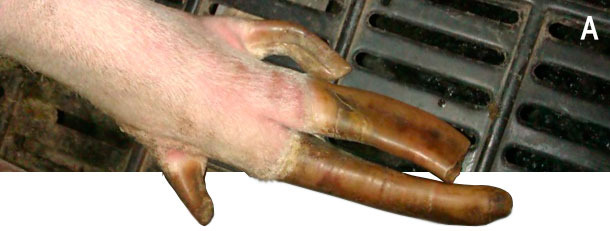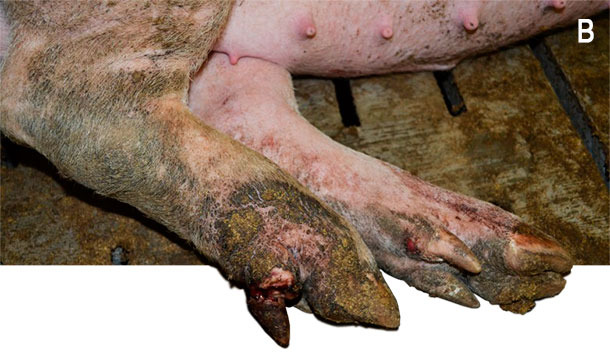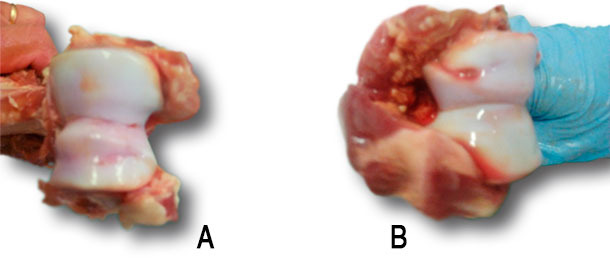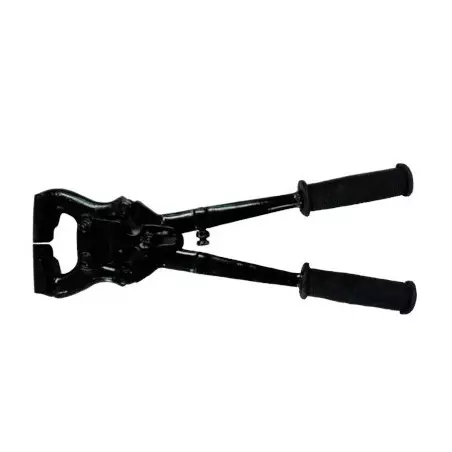Lameness is a major production disease of pigs and threatens the sustainability of current pig production methods due to its high prevalence and its detrimental impact on profitability. It is a major cause of premature culling in the breeding herd, particularly in gilts and young sows. It reduces farm profitability through the increased involuntary culling rate of sows, increased expenses as a result of treatment, labour requirement and the cost incurred in replacing sows, and through the consequential reduction in pigs produced per sow per year.
Understanding potential causes of lameness can help reduce the levels of lameness in the breeding herd and thus improve farm productivity and sow welfare. The causes of lameness can be infectious or non-infectious and can be influenced by environmental conditions, husbandry decisions, nutrition and genetic factors. Non-infectious causes of lameness in sows are more common than infectious causes, likely due to the ability of older animals to defend against infectious causes due to previous exposure in their lifetime or through vaccination, so this article will focus on the main non-infectious causes. Non-infectious cases of lameness include physical injury or osteochondrosis.

Physical Injury
Physical injuries such as limb lesions, claw lesions, muscle damage, tendon damage and bone fractures have been linked with sow lameness.
Limb lesions
Lesions such as wounds, swellings, calluses, capped hock and bursitis are associated with lameness. This relationship is complex however, and not comprehensively understood. Obviously painful injuries such as severe wounds, swellings and abscesses may result in lameness, while on the other hand a lame sow may spend longer times lying, increasing contact time between the skin and the flooring increasing susceptibility to skin limb lesions. Therefore limb lesions may cause lameness and lameness may cause limb lesions.

Example of limb lesions; A) limb inflammation and abscess, B) carpus callus and C) bursitis and tarsal callus.
Claw lesions
Claw lesions are a common injury in sows with almost all sows having one or more claw lesion. Commonly observed claw lesions include wall cracks, heel overgrowth, heel erosion, heel-sole separation, white line separation, dew claw and toe overgrowth, and dew claw amputation. The relationship between lameness and these claw lesions is largely dependent on the location and severity of the lesion, with the corium being more sensitive due to the abundance nerves and blood vessels. Therefore minor claw lesions, which do not penetrate the corium, may not result in pain and are therefore not associated with lameness while severe lesions, or those which penetrate the corium, are frequently associated with lameness.


Example of claw lesions; A) overgrown toes and dew claw and B) amputated dew claw.

Muscle damage, tendon damage and bone fractures
Trauma may also result in muscle and tendon damage and in severe cases bone fractures, which can cause lameness.
Osteochondrosis
Osteochondrosis is a known cause of leg weakness in sows that has frequently been associated with lameness and premature culling for lameness; however this is not always the case. It results in irreversible damage of the articular cartilage underlying bone of joints, most frequently the elbow joint. Osteochondrosis is difficult to identify in live sows, unlike limb and claw lesions, as there are no reliable external indicators.

Osteochondrosis of the humeral condyle (elbow joint): A) no irregularity of the cartilage, and B) severe irregularity of the cartilage
Environmental influences on lameness
A number of environment and husbandry decisions can influence lameness. Such factors include; floor type, housing system, stocking density, group size, growth rate and nutrition.
Floor type
Floor conditions have major impact on lameness. Features of the floor that influence lameness include floor quality (damage, presence of hazards), proportion of solid, fully slatted, partially slatted and fully solid flooring, flooring material (soil, concrete, metal, plastic, rubber), bedding provision/quantity and cleanliness.
Group size and stocking density
Group size influences limb health as some studies have found that pigs kept in larger groups tend to have higher limb lesion and lameness scores.
Housing system
Pregnant sows can be either group housed in pens or individually housed in gestation stalls. In the European Union all member states are required to group house sows from 4 weeks after service until one week before farrowing since January 2013. This is expected to have resulted in an increase in lameness levels in these countries, as lameness prevalence is higher in loose housed systems in comparison to gestations stalls. This is due to the mixing of unfamiliar pigs resulting in aggressive behaviour as the animals attempt to establish a dominance hierarchy.
Nutrition
Lameness and claw lesions can be influenced by gilt and sow nutrition, particularly in relation to diet composition, feed intake and nutritional management. Nutrition is directly related to claw, bone and cartilage physiology and can also indirectly affect limb health through the effect of weight gain.
Gilts and young sows are particularly susceptible to lameness as a result of inadequate nutrition during their development as some producers feed diets formulated for finisher pigs to replacement gilts until service or alternatively feed diets formulated for pregnant sows to growing gilts from gilt selection to service. Such regimes are not nutritionally suitable for a developing gilt; a gestating sow diet is formulated for a mature animal that has completed its growth and a finisher diet is formulated for rapid growth rates, high lean meat deposition and cost efficiency. In contrast specifically formulated gilt diets that are designed for young females, take the nutrient requirements for skeletal and reproductive development, and fat deposition into account. The use of tailored gilt feeding regimes has resulted in reduced lameness levels.





